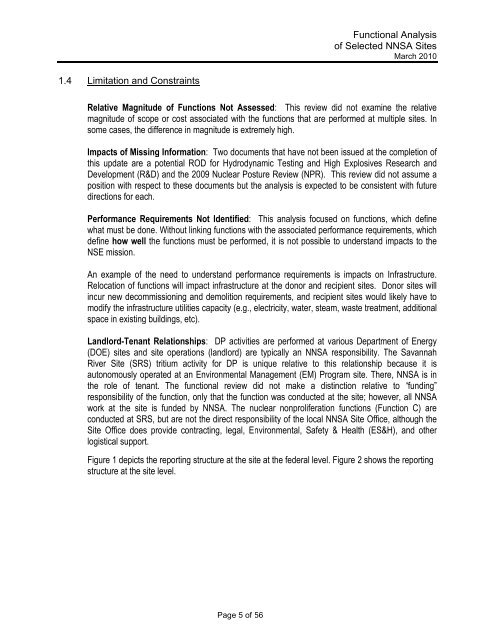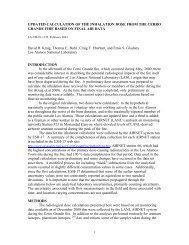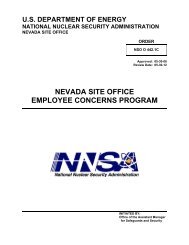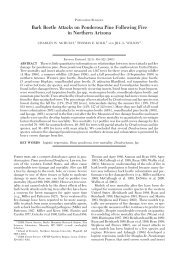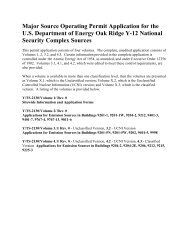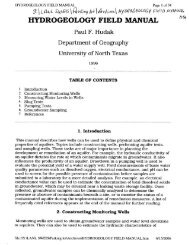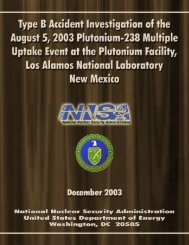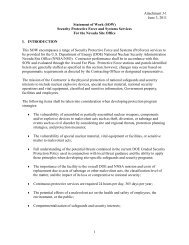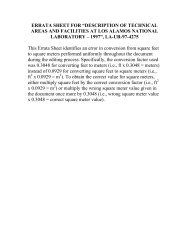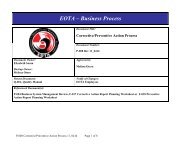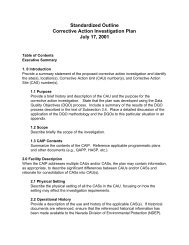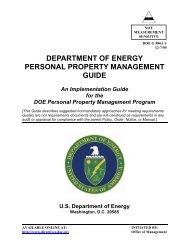<strong>Functional</strong> <strong>Analysis</strong><strong>of</strong> <strong>Selected</strong> <strong>NNSA</strong> <strong>Sites</strong>March 20101.0 Introduction and BackgroundA very thorough functional analysis was completed for the <strong>Nuclear</strong> Security Enterprise (NSE) inSeptember 2007 (Reference 1). Since the completion <strong>of</strong> that study, the NSE has been undergoingchanges that were thought to be significant enough to warrant an update and revalidation <strong>of</strong> the2007 study. In particular, key decision documents 1 2 have been issued after the publication <strong>of</strong> theSupplemental Programmatic Environmental Impact Statement (Reference 2).1.1 Purpose <strong>of</strong> this <strong>Functional</strong> <strong>Analysis</strong> UpdateThe contracts for Pantex (PX), Y-12, and the Kansas City Plant (KCP) expire towards the end <strong>of</strong>2010. In support <strong>of</strong> the <strong>NNSA</strong> NSE Acquisition Strategy for these contracts, an interim update toReference 1 was considered necessary because <strong>of</strong> the changes that have occurred withtransforming the weapons complex enterprise. Savannah River Site (SRS) Tritium Operationswas also included even though the overall site contract had recently been re-competed. Theadditional information for Tritium was easier to obtain because <strong>of</strong> the clause placed in the currentcontract, administered by the Environmental Management (EM) Program, for the Managementand Operating contractor to complete a “severability” study to understand the actions needed totransfer Tritium to a separate <strong>NNSA</strong> contract.The update is intended be provided to potential bidders as supplemental information to thestatement <strong>of</strong> work that would be contained in the Request for Proposals for potential competition<strong>of</strong> the plant contracts. As time allows, a similar update will be conducted for Sandia <strong>National</strong>Laboratory (SNL), Los Alamos <strong>National</strong> Lab (LANL), Lawrence Livermore <strong>National</strong> Laboratory(LLNL), and the Nevada Test site (NTS). The culmination <strong>of</strong> the entire effort would then bepublished in a full revision to Reference 1.1.2 ScopeThe scope <strong>of</strong> this updated report is to revalidate the functions and interfaces described inReference 1 for PX, Y-12, KCP, and SRS Tritium Operations. This report also expands theevaluation <strong>of</strong> functions related to nuclear nonproliferation, Naval Reactors propulsion programs,and Work for Others and provides a much more detailed evaluation for information flow andinterfaces, an area given only cursory attention in Reference 1.1.3 ApproachThe approach used to revalidate the functions and interfaces described in Appendix B.1 Documentation includes the following : Department <strong>of</strong> Energy Record <strong>of</strong> Decision for the Complex Transformation Supplemental Programmatic Environmental ImpactStatement—Operations Involving Plutonium, Uranium, and the Assembly and Disassembly <strong>of</strong> <strong>Nuclear</strong> Weapons – December 19, 2008 Department <strong>of</strong> Energy Record <strong>of</strong> Decision for the Complex Transformation Supplemental Programmatic Environmental ImpactStatement—Tritium Research and Development, Flight Test Operations, and Major Environmental Test Facilities – December 19, 20082<strong>NNSA</strong> <strong>Nuclear</strong> Security Enterprise Acquisition Strategy, April 30, 2009Page 4 <strong>of</strong> 56
<strong>Functional</strong> <strong>Analysis</strong><strong>of</strong> <strong>Selected</strong> <strong>NNSA</strong> <strong>Sites</strong>March 20101.4 Limitation and ConstraintsRelative Magnitude <strong>of</strong> Functions Not Assessed: This review did not examine the relativemagnitude <strong>of</strong> scope or cost associated with the functions that are performed at multiple sites. Insome cases, the difference in magnitude is extremely high.Impacts <strong>of</strong> Missing Information: Two documents that have not been issued at the completion <strong>of</strong>this update are a potential ROD for Hydrodynamic Testing and High Explosives Research andDevelopment (R&D) and the 2009 <strong>Nuclear</strong> Posture Review (NPR). This review did not assume aposition with respect to these documents but the analysis is expected to be consistent with futuredirections for each.Performance Requirements Not Identified: This analysis focused on functions, which definewhat must be done. Without linking functions with the associated performance requirements, whichdefine how well the functions must be performed, it is not possible to understand impacts to theNSE mission.An example <strong>of</strong> the need to understand performance requirements is impacts on Infrastructure.Relocation <strong>of</strong> functions will impact infrastructure at the donor and recipient sites. Donor sites willincur new decommissioning and demolition requirements, and recipient sites would likely have tomodify the infrastructure utilities capacity (e.g., electricity, water, steam, waste treatment, additionalspace in existing buildings, etc).Landlord-Tenant Relationships: DP activities are performed at various Department <strong>of</strong> Energy(DOE) sites and site operations (landlord) are typically an <strong>NNSA</strong> responsibility. The SavannahRiver Site (SRS) tritium activity for DP is unique relative to this relationship because it isautonomously operated at an Environmental Management (EM) Program site. There, <strong>NNSA</strong> is inthe role <strong>of</strong> tenant. The functional review did not make a distinction relative to “funding”responsibility <strong>of</strong> the function, only that the function was conducted at the site; however, all <strong>NNSA</strong>work at the site is funded by <strong>NNSA</strong>. The nuclear nonproliferation functions (Function C) areconducted at SRS, but are not the direct responsibility <strong>of</strong> the local <strong>NNSA</strong> Site Office, although theSite Office does provide contracting, legal, Environmental, Safety & Health (ES&H), and otherlogistical support.Figure 1 depicts the reporting structure at the site at the federal level. Figure 2 shows the reportingstructure at the site level.Page 5 <strong>of</strong> 56


